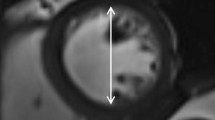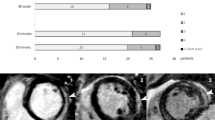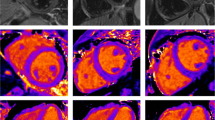Abstract
To establish extracellular volume fraction (ECV) thresholds corresponding to myocardial lesion detected by late-gadolinium enhancement (LGE) cardiac magnetic resonance (CMR) imaging. Fifty-six patients with myocardial infarction or hypertrophic cardiomyopathy underwent LGE, pre- and post-contrast modified Look-Locker inversion recovery (MOLLI) sequences on a 3-T CMR system. Short-axis MOLLI images generated ECV maps of left ventricular (LV) walls. The LGE areas were semi-automatically determined by different signal threshold techniques. The areas of elevated ECV were measured using ECV thresholds of 28–48 %. The LGE areas were compared with the areas of elevated ECV at the corresponding LV levels. The myocardial areas of LGE and elevated ECVs showed a strong and positive correlation (P < 0.01). The LGE threshold, set at two standard deviations above the mean signal from the remote myocardium, corresponded well with the area of ECV >32 %. When using the full width at half-maximum (FWHM) technique, the LGE area corresponded well with the area of ECV >42 or 44 %. By applying particular ECV thresholds, myocardial ECV maps can define myocardial status equivalent to LGE, and definite ECV thresholds may be useful for the straightforward evaluation of myocardial phenotypes.





Similar content being viewed by others
References
Kim RJ, Fieno DS, Parrish TB et al (1999) Relationship of MRI delayed contrast enhancement to irreversible injury, infarct age, and contractile function. Circulation 100(19):1992–2002
Mahrholdt H, Wagner A, Judd RM et al (2005) Delayed enhancement cardiovascular magnetic resonance assessment of non-ischaemic cardiomyopathies. Eur Heart J 26(15):1461–1474
Kim RJ, Wu E, Rafael A et al (2000) The use of contrast-enhanced magnetic resonance imaging to identify reversible myocardial dysfunction. N Engl J Med 343(20):1445–1453
Flett AS, Hayward MP, Ashworth MT et al (2010) Equilibrium contrast cardiovascular magnetic resonance for the measurement of diffuse myocardial fibrosis: preliminary validation in humans. Circulation 122(2):138–144
Weber KT, Brilla CG (1991) Pathological hypertrophy and cardiac interstitium. Fibrosis and renin-angiotensin-aldosterone system. Circulation 83(6):1849–1865
Schwartzkopff B, Brehm M, Mundhenke M et al (2000) Repair of coronary arterioles after treatment with perindopril in hypertensive heart disease. Hypertension 36(2):220–225
Tamarappoo BK, John BT, Reinier K et al (2012) Vulnerable myocardial interstitium in patients with isolated left ventricular hypertrophy and sudden cardiac death: a postmortem histological evaluation. J Am Heart Assoc 1(3):e001511
Wong TC, Piehler K, Meier CG et al (2012) Association between extracellular matrix expansion quantified by cardiovascular magnetic resonance and short-term mortality. Circulation 126(10):1206–1216
Fontana M, White SK, Banypersad SM et al (2012) Comparison of T1 mapping techniques for ECV quantification. Histological validation and reproducibility of ShMOLLI versus multibreath-hold T1 quantification equilibrium contrast CMR. J Cardiovasc Magn Reson 14:88
Coelho-Filho OR, Shah RV, Mitchell R et al (2013) Quantification of cardiomyocyte hypertrophy by cardiac magnetic resonance: implications for early cardiac remodeling. Circulation 128(11):1225–1233
Messroghli DR, Radjenovic A, Kozerke S et al (2004) Modified Look-Locker inversion recovery (MOLLI) for high-resolution T1 mapping of the heart. Magn Reson Med 52(1):141–146
Messroghli DR, Plein S, Higgins DM et al (2006) Human myocardium: single-breath-hold MR T1 mapping with high spatial resolution–reproducibility study. Radiology 238(3):1004–1012
Ugander M, Oki AJ, Hsu LY et al (2012) Extracellular volume imaging by magnetic resonance imaging provides insights into overt and sub-clinical myocardial pathology. Eur Heart J 33(10):1268–1278
Liu S, Han J, Nacif MS et al (2012) Diffuse myocardial fibrosis evaluation using cardiac magnetic resonance T1 mapping: sample size considerations for clinical trials. J Cardiovasc Magn Reson 14:90
Bland JM, Altman DG (1986) Statistical methods for assessing agreement between two methods of clinical measurement. Lancet 1(8476):307–310
Flett AS, Westwood MA, Davies LC et al (2009) The prognostic implications of cardiovascular magnetic resonance. Circ Cardiovasc Imaging 2(3):243–250
Schmidt A, Azevedo CF, Cheng A et al (2007) Infarct tissue heterogeneity by magnetic resonance imaging identifies enhanced cardiac arrhythmia susceptibility in patients with left ventricular dysfunction. Circulation 115(15):2006–2014
Skardal K, Rolim NP, Haraldseth O et al (2013) Late gadolinium enhancement in the assessment of the infarcted mouse heart: a longitudinal comparison with manganese-enhanced MRI. J Magn Reson Imaging 38(6):1388–1394
Ellims AH, Iles LM, Ling LH et al (2012) Diffuse myocardial fibrosis in hypertrophic cardiomyopathy can be identified by cardiovascular magnetic resonance, and is associated with left ventricular diastolic dysfunction. J Cardiovasc Magn Reson 14:76
Yan AT, Shayne AJ, Brown KA et al (2006) Characterization of the peri-infarct zone by contrast-enhanced cardiac magnetic resonance imaging is a powerful predictor of post-myocardial infarction mortality. Circulation 114(1):32–39
Heidary S, Patel H, Chung J et al (2010) Quantitative tissue characterization of infarct core and border zone in patients with ischemic cardiomyopathy by magnetic resonance is associated with future cardiovascular events. J Am Coll Cardiol 55(24):2762–2768
Todiere G, Aquaro GD, Piaggi P et al (2012) Progression of myocardial fibrosis assessed with cardiac magnetic resonance in hypertrophic cardiomyopathy. J Am Coll Cardiol 60(10):922–929
Flett AS, Hasleton J, Cook C et al (2011) Evaluation of techniques for the quantification of myocardial scar of differing etiology using cardiac magnetic resonance. JACC Cardiovasc Imaging 4(2):150–156
Kellman P, Wilson JR, Xue H et al (2012) Extracellular volume fraction mapping in the myocardium, part 1: evaluation of an automated method. J Cardiovasc Magn Reson 14:63
Kellman P, Wilson JR, Xue H et al (2012) Extracellular volume fraction mapping in the myocardium, part 2: initial clinical experience. J Cardiovasc Magn Reson 14:64
Wong TC, Piehler KM, Kang IA et al (2013) Myocardial extracellular volume fraction quantified by cardiovascular magnetic resonance is increased in diabetes and associated with mortality and incident heart failure admission. Eur Heart J 35(10):657–664
Conflict of interest
The authors declare no conflict of interest.
Author information
Authors and Affiliations
Corresponding author
Rights and permissions
About this article
Cite this article
Hwang, S.H., Choi, EY., Park, C.H. et al. Evaluation of extracellular volume fraction thresholds corresponding to myocardial late-gadolinium enhancement using cardiac magnetic resonance. Int J Cardiovasc Imaging 30 (Suppl 2), 137–144 (2014). https://doi.org/10.1007/s10554-014-0489-6
Received:
Accepted:
Published:
Issue Date:
DOI: https://doi.org/10.1007/s10554-014-0489-6




